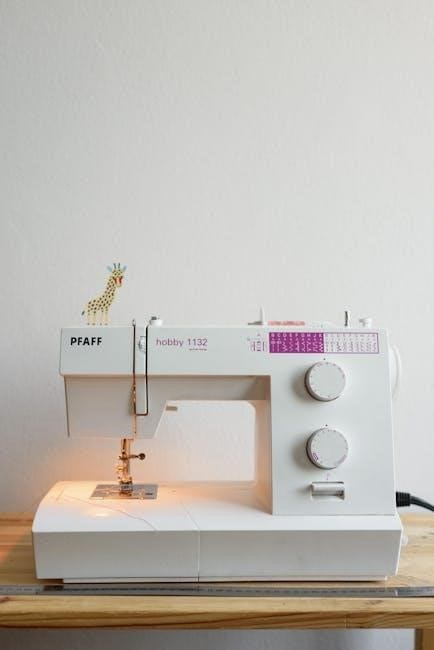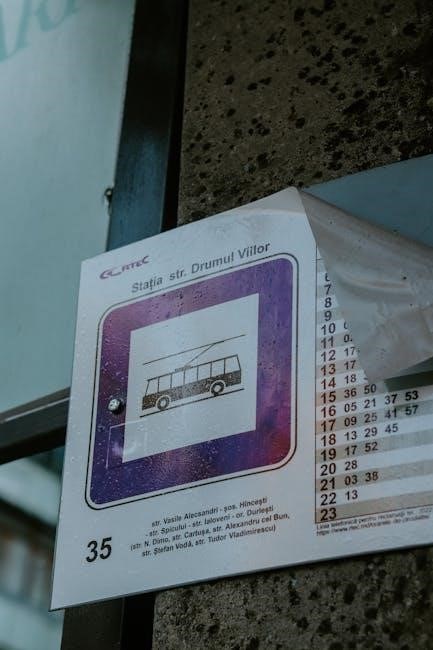Welcome to the Brother Sewing Machine Instruction Manual. This guide provides step-by-step instructions for operating, maintaining, and troubleshooting your machine, ensuring optimal performance and creativity.
Overview of the Manual
This manual is a comprehensive guide for setting up, operating, and maintaining your Brother sewing machine. It covers threading, bobbin winding, basic functions, troubleshooting, and maintenance. The manual also provides tips for customizing stitch settings and ensuring safety. For detailed guidance, refer to the included diagrams and downloadable PDF resources available online.
Importance of Reading the Manual
Reading the manual ensures safe operation and optimal performance of your Brother sewing machine. It provides essential guidance on threading, troubleshooting, and maintenance. Understanding the instructions helps prevent damage and enhances your sewing experience. Regular maintenance, as outlined, prolongs machine life and ensures reliability. Whether you’re a beginner or experienced sewer, the manual offers valuable tips to maximize your machine’s potential and achieve professional results.
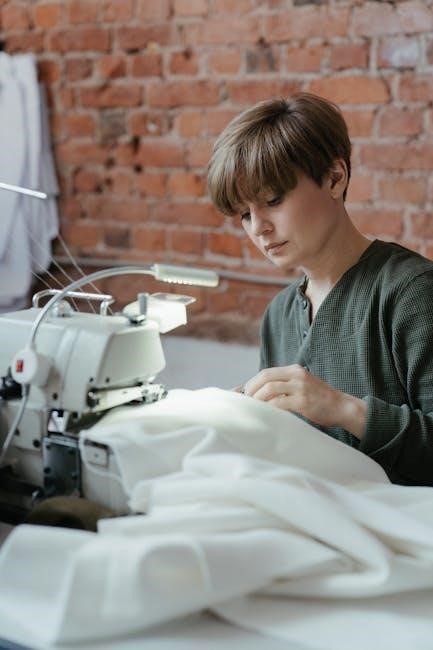
Safety Precautions and Guidelines
Always follow safety guidelines to ensure safe operation. Use the machine only as intended, avoid loose clothing near moving parts, and keep children away while sewing.
General Safety Tips
- Always keep loose clothing and long hair tied back while sewing.
- Avoid sewing over pins to prevent needle breakage and injury.
- Ensure the workspace is well-lit and free from clutter.
- Keep children and pets away from the machine while in use.
- Never touch the needle or other moving parts with your hands.
- Use only recommended accessories to maintain safety and performance.
- Regularly inspect the machine for damage or wear.
Following these guidelines ensures a safe and enjoyable sewing experience.
Manufacturer’s Warnings and Recommendations
Manufacturer’s Warnings and Recommendations
- Use only genuine Brother accessories to ensure compatibility and safety.
- Avoid modifying the machine or using unauthorized parts.
- Keep the machine on a stable, vibration-resistant table.
- Do not sew near flammable materials or in hazardous environments.
- Follow the manual’s guidelines for oiling and maintenance.
- Always unplug the machine during cleaning or maintenance.
Adhering to these recommendations ensures safe operation and extends the machine’s lifespan.
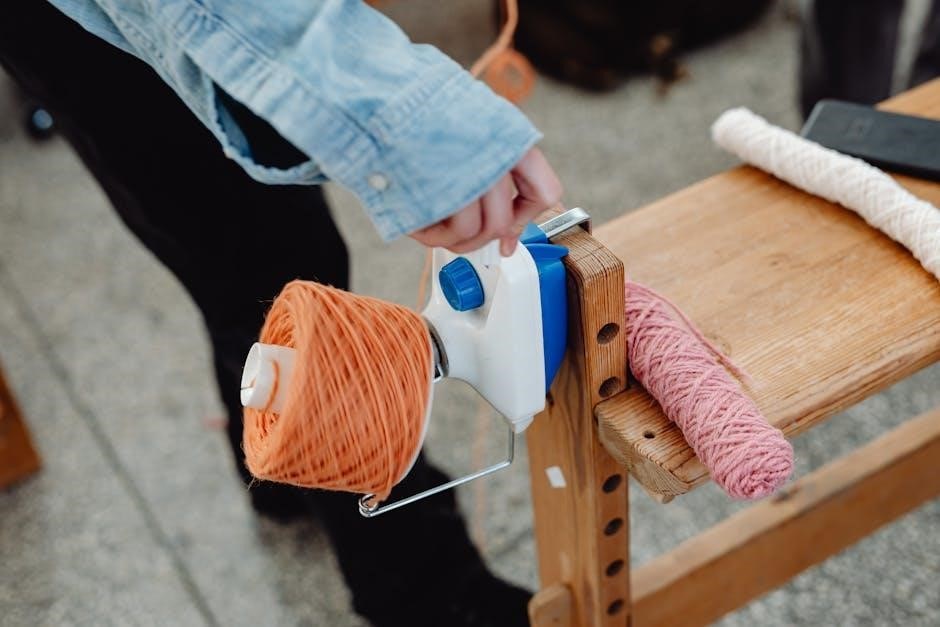
Unpacking and Setting Up Your Brother Sewing Machine
Exciting to start! Carefully unpack your Brother sewing machine, ensuring all accessories like bobbins, needles, and the manual are included. Prepare a stable workspace.
What’s Included in the Box
Your Brother sewing machine box typically includes the machine, power cord, foot controller, and a variety of accessories like needles, bobbins, and a stitching guide. Some models may also include specialized feet for tasks like zippers or buttonholes. Always check the contents against the manual’s list to ensure nothing is missing. Organize these items neatly for easy access when you begin your sewing projects.
Preparing Your Workspace
Set up your sewing area on a sturdy, vibration-resistant table with a thickness of 49-60 mm for stability. Ensure the surface is clear and well-lit to enhance visibility. Organize your sewing essentials, such as threads, needles, and fabric, within easy reach. For heavier machines, consider a table with built-in storage or ergonomic adjustments to ensure comfort during extended sewing sessions.
Understanding Your Brother Sewing Machine
Explore your machine’s features, including basic parts, accessories, and control panel functions. This section helps you familiarize yourself with the components for smooth operation and troubleshooting.
Machine Parts and Accessories
Your Brother sewing machine comes with essential parts like the needle, bobbin, presser foot, and spool pins. Accessories include various presser feet for zippers, buttons, and quilting. The control panel features buttons for stitch selection, speed control, and reverse sewing. Additional items like extra bobbins, needles, and screwdrivers are often included. Familiarizing yourself with these components ensures proper setup and operation. Optional accessories can expand your machine’s functionality for specialized sewing tasks.
Control Panel and Basic Functions
The control panel is the central hub for operating your Brother sewing machine. It features buttons for stitch selection, speed control, and reverse sewing. Use the navigation buttons to scroll through stitch options and adjust settings. The panel also includes a display screen showing the selected stitch, length, and width. Basic functions like starting, stopping, and reversing stitches are easily managed with dedicated controls. Familiarize yourself with these features to optimize your sewing experience.
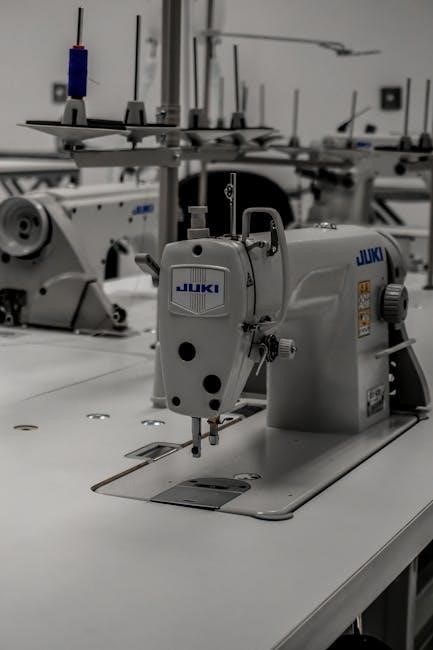
Threading and Winding the Bobbin
Threading and winding the bobbin are crucial steps. Properly guide the thread through the machine’s tension discs and take-up lever. Wind the bobbin evenly for smooth stitching.
Step-by-Step Threading Guide
Start by locating the spool pin and pulling the thread. Insert the thread into the tension disc, then guide it through the take-up lever. Gently pull the thread to ensure it’s seated properly. Next, thread the needle from front to back and pull the thread to create a small loop. Finally, trim the excess thread close to the needle to complete the process. Always follow the manual’s specific guidance for your model.
Proper Bobbin Winding Techniques
To wind the bobbin correctly, start by preparing your machine and thread. Attach the thread to the spindle, then thread the bobbin through its hole, leaving a 6-inch tail. Secure the bobbin on the winder and slowly turn the handwheel to wind the thread evenly, avoiding overfilling. Stop when the bobbin is three-quarters full, cut the thread, and remove it. Always use the recommended thread type and follow the manual’s specific instructions for your Brother model to ensure optimal performance and avoid sewing issues.
Basic Sewing Operations
Learn essential sewing skills with your Brother machine. Master threading, fabric placement, and basic stitch functions. Start with simple projects to build confidence and sewing proficiency.
Starting Your First Sewing Project
Begin by threading your machine and winding the bobbin correctly. Place fabric under the needle, aligning edges carefully. Select a straight stitch for simplicity. Start with a scrap piece to ensure proper tension and stitch formation. Sew slowly, guiding fabric smoothly. Practice basic forward and reverse stitching to build confidence. Always refer to the manual for specific settings and troubleshooting tips to ensure a successful first project.
Forward and Reverse Sewing
Engage forward sewing by ensuring the reverse lever is in the upright position. For reverse sewing, gently pull down the lever to secure stitches at the beginning or end of your seam. This feature is ideal for preventing fabric from unraveling. Always test the stitch direction on scrap fabric to ensure proper function. Use reverse sewing sparingly to maintain seam integrity and professional results.
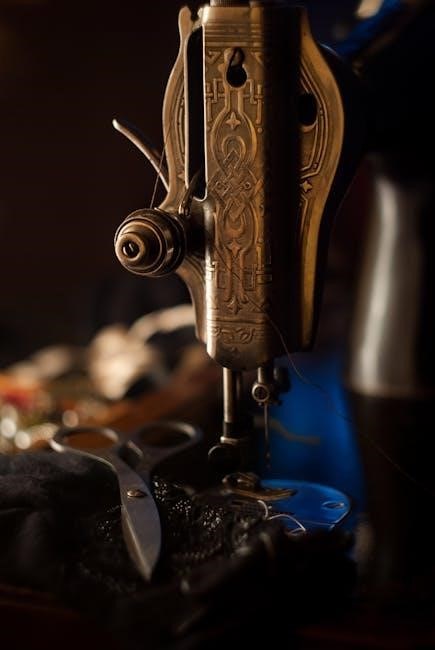
Stitch Selection and Customization
Explore various stitch options, including straight, zigzag, and decorative patterns. Adjust stitch length and width to suit your fabric type. Customize settings for personalized sewing results.
Types of Stitches Available
Your Brother sewing machine offers a variety of stitch options, including straight stitch, zigzag, blind hem, and stretch stitches. Decorative stitches like satin and appliqué stitches are also available. These stitches cater to different fabrics and sewing needs, allowing you to create versatile and professional-looking projects. The machine’s stitch selection ensures adaptability for both basic and advanced sewing tasks, enhancing your creativity and efficiency.
Adjusting Stitch Length and Width
Adjusting stitch length and width on your Brother sewing machine allows for customization to suit various fabrics and sewing projects. Use the control panel or stitch selection dial to modify settings. Stitch length typically ranges from 0 to 5mm, while width adjusts for zigzag and decorative stitches. Proper adjustments ensure even stitching, preventing fabric stretching or puckering. Experiment with settings to achieve the desired texture and appearance for your sewing tasks, enhancing both functionality and creativity.
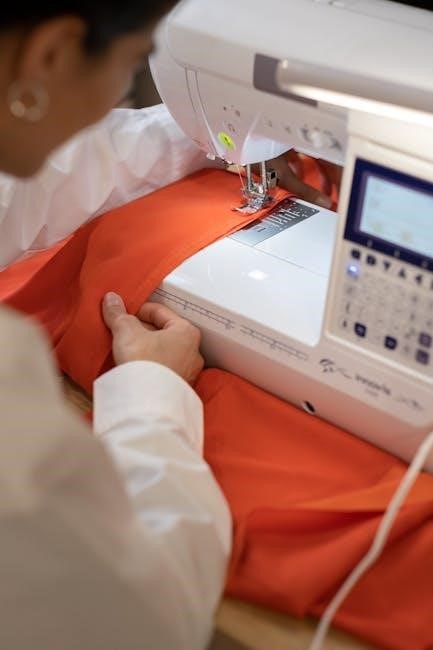
Maintenance and Care
Regular maintenance ensures your Brother sewing machine operates smoothly. Clean dust and debris, oil moving parts, and follow the recommended schedule to prevent wear and tear.
Cleaning and Oiling the Machine
Regular cleaning and oiling are essential to maintain your Brother sewing machine’s performance. Turn off and unplug the machine before starting. Use a soft brush to remove dust and debris from the bobbin area and tension discs. Apply a few drops of high-quality sewing machine oil to moving parts, such as the hook race and shuttle. Avoid over-oiling to prevent residue buildup. Clean the exterior with a soft cloth to keep it dust-free and ensure smooth operation.
Regular Maintenance Schedule
Adhere to a regular maintenance schedule to keep your Brother sewing machine in top condition. Clean the bobbin area and tension discs weekly, and oil moving parts every 1-2 months. Check for loose screws and lubricate the shuttle hook every 3-6 months. Replace the needle regularly and inspect belts and cables annually. Schedule professional servicing every 12-18 months for thorough inspection and adjustment. Refer to your manual for specific maintenance intervals tailored to your machine model.
Troubleshooting Common Issues
This section is your guide to identifying and resolving common problems, such as thread breakage or machine noise, ensuring smooth operation and minimizing downtime.
Identifying and Solving Thread Breakage
Thread breakage can occur due to improper tension, incorrect needle size, or tangled threads. Check the thread path for obstructions and ensure the needle is inserted correctly. Use the recommended thread type and adjust the tension settings as outlined in the manual. Regularly clean the machine to prevent dust buildup, which can cause thread breakage. If issues persist, refer to the troubleshooting section for additional guidance.
Fixing Machine Jamming or Noise
Machine jamming or noise often occurs due to improper threading, tangled threads, or debris buildup. Turn off the machine and carefully remove any tangled threads. Check the bobbin area for lint or fabric scraps and clean thoroughly; Ensure the needle is properly installed and aligned. Use the correct needle size and type for your fabric. If noise persists, apply a few drops of sewing machine oil to moving parts and consult the troubleshooting guide for further assistance.
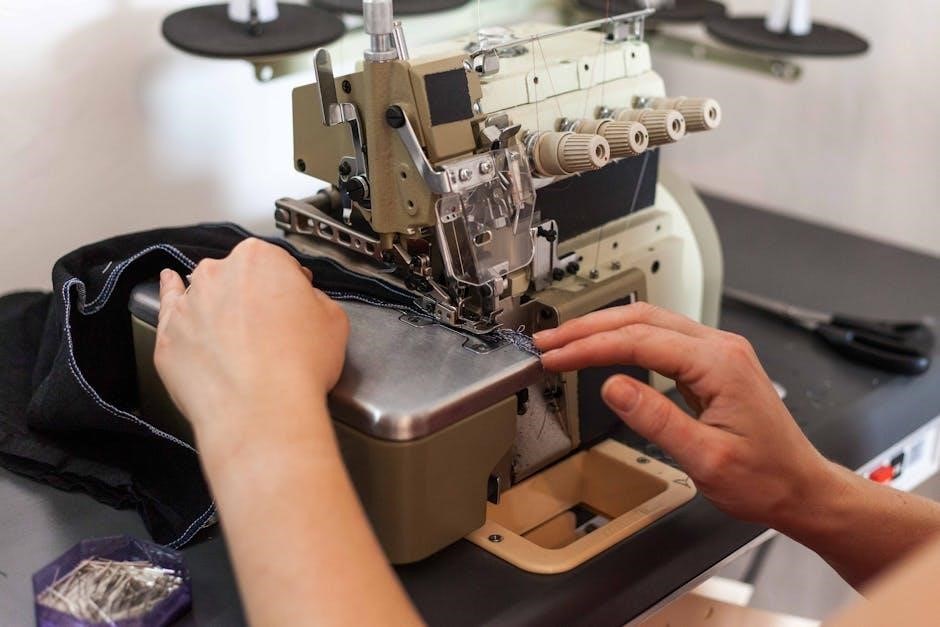
Advanced Features and Techniques
Explore advanced sewing techniques like programmable stitches, memory settings, and specialized presser feet. Customize your sewing experience with precision and creativity using Brother’s innovative features.
Using Specialized Feet and Accessories
Enhance your sewing experience with Brother’s specialized feet and accessories, designed for specific tasks. Use the zipper foot for precise zipper installation, the buttonhole foot for perfect buttonholes, and the walking foot for heavy fabrics. Explore optional accessories like quilting guides and extension tables for expanded creativity. Always use genuine Brother accessories to ensure compatibility and optimal performance. Refer to your manual for guidance on selecting and attaching the right tools for your projects.
Customizing Your Sewing Experience
Personalize your sewing projects with customizable stitch settings and advanced features. Adjust stitch length, width, and density to suit your fabric and design needs. Explore decorative stitches, alphabets, and memory functions for unique creations. Utilize the machine’s built-in tutorials and customizable settings to tailor your sewing experience. Experiment with different thread types and tensions to achieve professional results. By tailoring settings to your preferences, you can unlock endless creative possibilities and enhance your sewing efficiency.
Downloading and Accessing the Manual
Access the Brother Sewing Machine manual by visiting the Brother Solutions Center. Click on Manuals, enter your model number, and download the PDF for easy reference.
How to Download the Manual
To download the Brother Sewing Machine manual, visit the Brother Solutions Center website. Click on the Manuals section, enter your machine’s model number, and select the appropriate document. The manual will be available in PDF format for easy download and reference. Ensure your device has a PDF viewer installed. This process provides quick access to operating instructions, troubleshooting guides, and maintenance tips specific to your model.
Navigating the PDF Version
The PDF version of the Brother Sewing Machine manual is user-friendly and well-organized. Use bookmarks to quickly access sections like setup, operation, and troubleshooting. The table of contents provides easy navigation, while the search function helps locate specific topics. Zoom in or out for readability, and print individual pages as needed. This digital format ensures you can effortlessly find the information you need to operate and maintain your machine effectively.
Mastery of your Brother sewing machine begins with understanding its operation and maintenance. This manual guides you through setup, troubleshooting, and care, ensuring years of creative sewing.
Final Tips for Getting the Most Out of Your Machine
To maximize your Brother sewing machine’s performance, regularly clean and oil it, and use recommended accessories. Explore various stitch options and adjust tension for different fabrics. Keep the manual handy for troubleshooting and maintenance schedules. Organize your workspace and store the machine properly when not in use. Experiment with creative projects and stay updated on new techniques. Happy sewing!
